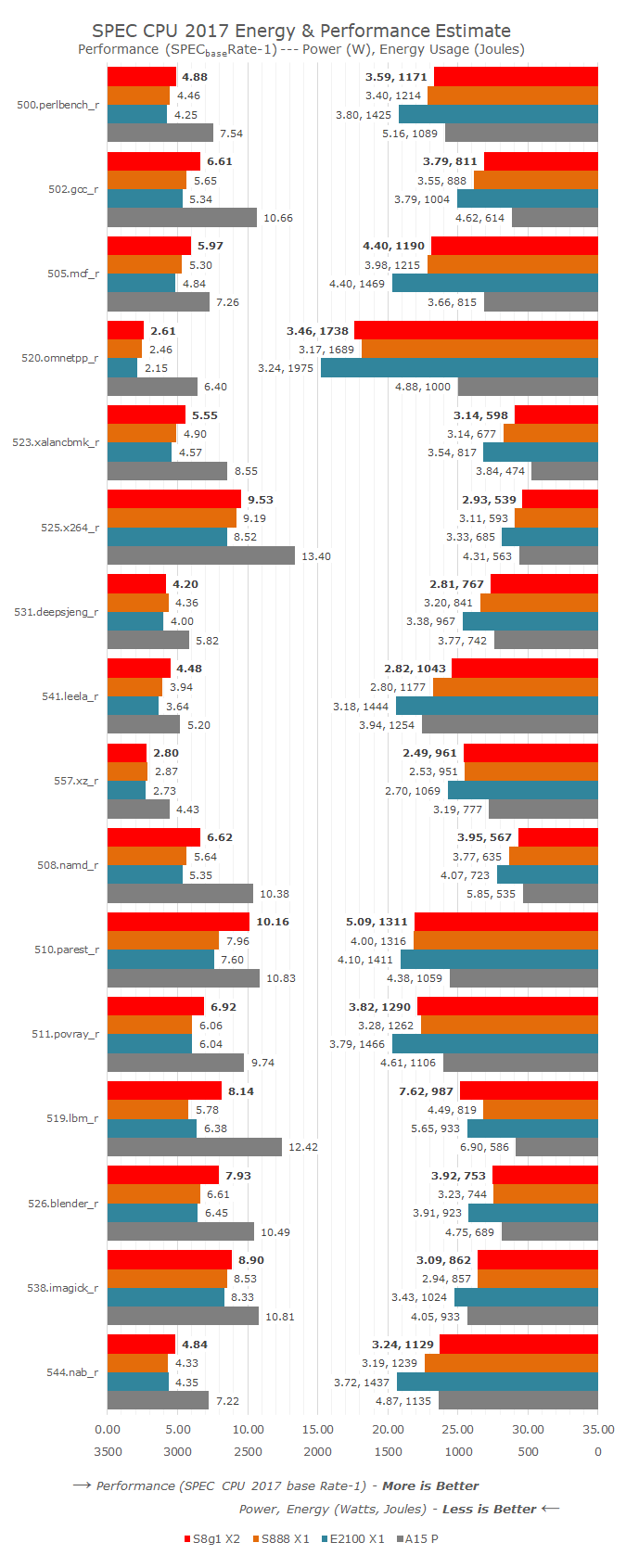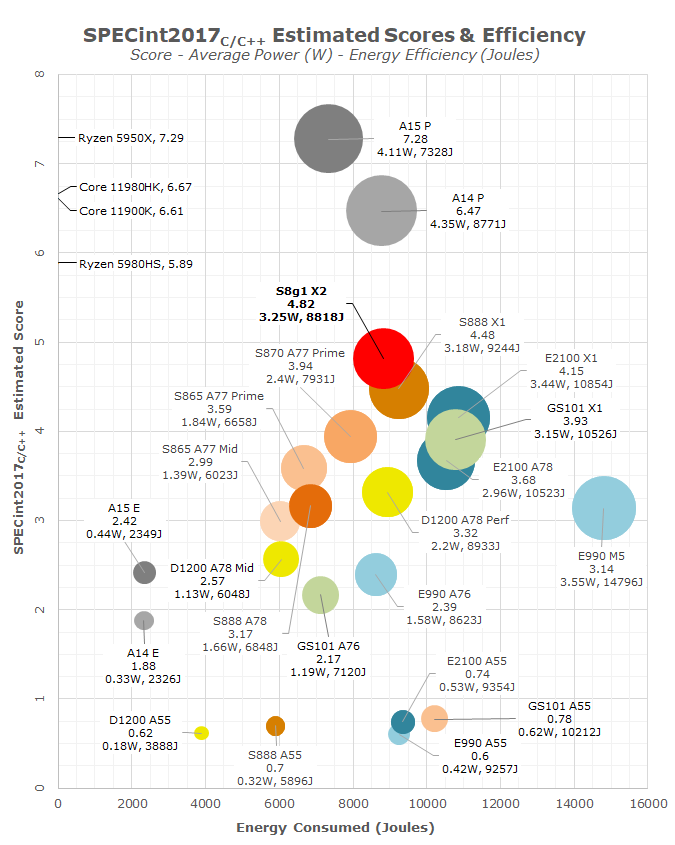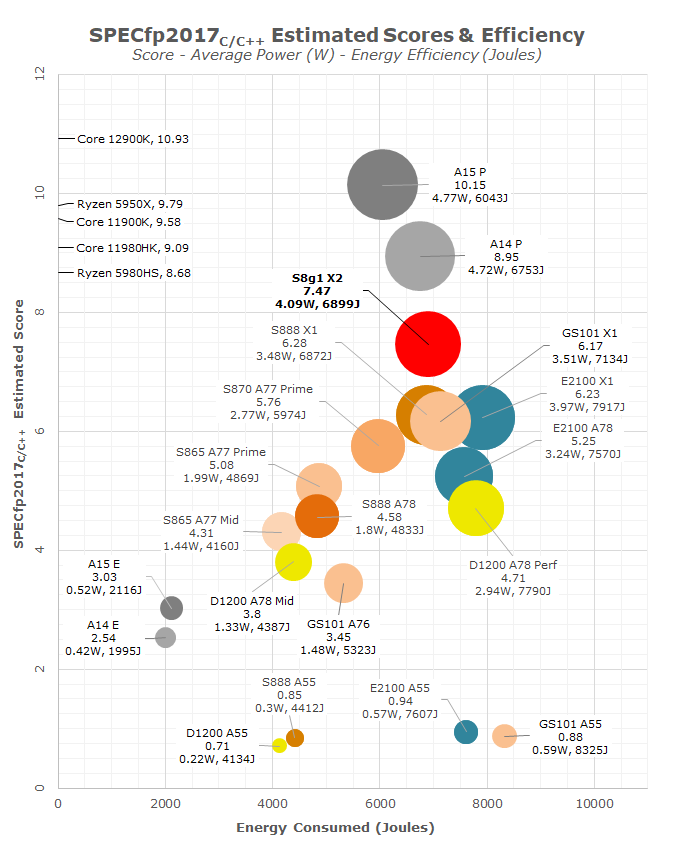The Snapdragon 8 Gen 1 Performance Preview: Sizing Up Cortex-X2
by Dr. Ian Cutress on December 14, 2021 8:00 AM ESTTesting the Cortex-X2: A New Android Flagship Core
Improving on the Cortex-X1 by switching to the Arm v9 architecture and increasing the core resources, both Arm and Qualcomm are keen to promote that the Cortex-X2 offers better performance and responsiveness than previous CPU cores. The small frequency bump from 2.85 GHz to 3.00 GHz will add some of that performance, however the question is always if the new manufacturing process coupled with the frequency increase allows for better power efficiency when running these workloads. Our standard analysis tool here is SPEC2017.
Running through some of these numbers, there are healthy gains to the core, and almost everything has a performance lift.
On the integer side (from 500.perlbench to 557.xr), there are good gains for gcc (+17%), mcf (+13%), xalancbmk (+13%), and leela (+14%), leading to an overall +8% improvement. Most of these integer tests involve cache movement and throughput, and usually gains in sub-tests like gcc can help a wide range of regular user workloads.
Looking at power and energy for the integer benchmarks, we’re seeing the X2 consume more instantaneous power on almost all the tests, but the efficiency is kicking in. That overall 8% performance gain is taking 5% less total energy, but on average requires 2% more peak power.
If we put this core up against all the other performance cores we test, we see that 8% jump in performance for 5% less energy used, and the X2 stands well above the X1 cores of the previous generation, especially those in non-Snapdragon processors. There is still a fundamental step needed to reach the Apple cores, even the previous-generation A14 performance core, which scores 34% higher for the same energy consumed (albeit on average another 34% peak power).
Just on these numbers, Qualcomm’s +20% performance or +30% efficiency doesn’t bare fruit, but the floating point numbers are significantly different.
Several benchmarks in 2017fp are substantially higher on the X2 this generation. +17% on namd for example would point to execution performance increases, but +28% in parest, +41% in lbm and +20% in blender showcases a mix of execution performance and memory performance. Overall we’re seeing +19% performance, which is nearer Qualcomm’s 20% mark. Note that this comes with an almost identical amount of energy consumed relative to the X1 core in the S888, with a difference of just 0.2%.
The major difference however is the average power consumed. For example, our biggest single test gain in 519.lbm is +41%, but where the S888 averages 4.49 watts, the new X2 core averages 7.62 watts. That’s a 70% increase in instantaneous power consumer, and realistically no single core in a modern smartphone should draw that much power. The reason why the power goes this high is because lbm leverages the memory subsystem, especially that 6 MiB L3 cache and relies on the 4 MiB system level cache, all of which consumes power. Overall in the lbm test, the +41% performance costs +20% energy, so efficiency is still +16% in this test. Some of the other tests, such as parest and blender, also follow this pattern.
Comparing against the competition, the X2 core does make a better generation jump when it comes to floating point performance. It will be interesting to see how other processors enable the X2 core, especially MTK’s flagship at slightly higher frequency, on TSMC N4, but also if it has access to a full 14 MiB combination of caches as we suspect, that could bring the power draw during single core use a lot higher. It will be difficult to tease out exactly who wins what where based on implementation vs. process node, but it will be a fun comparison to make when we look purely at the X2 vs. X2 cores.
Unfortunately due to how long SPEC takes to run (1h30 on the X2), we were unable to test on the A710/A510. We’ll have to wait to see when we get a retail unit.













169 Comments
View All Comments
tuxRoller - Tuesday, December 14, 2021 - link
Android let's you do this? With root, sure, but that's hardly a supported experience & certainly isn't a stable one unless you are willing to go without Google services.Although I still will not pay for an Apple device, Google has convinced me they aren't interested in making Android great for consumers. They can't even be trusted to reliably sync browser data & that is a f*|<ing trivial problem.
Dolda2000 - Tuesday, December 14, 2021 - link
Running Linux on desktop computers isn't exactly a "supported" configuration either. Fortunately, it doesn't have to be, and the same thing is generally true for Android phones as well (though not quite as true as it should be, to be sure).tuxRoller - Wednesday, December 15, 2021 - link
They aren't the same thing.For one, yes, Linux is a supported OS on certain, mostly enterprise, machines, though I do understand your point.
Second, phones don't yet have an equivalence to acpi & UEFI, so you're largely at the mercy of the OEM.
Am I missing something?
Fulljack - Wednesday, December 15, 2021 - link
nah, I'm using root and all my google services—even banking apps are fine. what are you talking about?Meteor2 - Friday, December 17, 2021 - link
Chrome syncs perfectly between Windows, iPadOS, and Android for me.TheinsanegamerN - Friday, December 17, 2021 - link
I can plug my android phone into any PC and browse the filesystem to my hearts content. I can upload my own music to any folder I wish, load ROMs, ece.Nicon0s - Saturday, December 18, 2021 - link
"Android let's you do this?"Yes it does.
Qasar - Tuesday, December 14, 2021 - link
" As usual, it's far slower than iPhones. People are getting ripped off when they buy slower Android hardware instead of iPhones. "ill take the android phones over the iphone any day, im NOT paying for the apple tax, ( apple's products are just too over priced) and the fact, that you cant add storage to them via a micro SD card. so no thanks, owning anything made by apple, is more of a status symbol, then anything else now
Duncan Macdonald - Tuesday, December 14, 2021 - link
That depends on what they use their phones for. For people who do not play demanding games on their phones Android phones are far better value for money, for people that do play demanding games then the higher performance from Apple may be worth the much higher cost.Reflex - Tuesday, December 14, 2021 - link
The 6-10 years of support for iPhones more than mitigates what is at this point a very minor price difference outside of the very low end. iPhone SE is only $400 after all. Android phones in that price range are not great performers and have at best 2 years of support typically.Even a used iPhone will typically have years more support than a comparably cheap new Android device, and for a non-power user that's great. I'll likely never have to upgrade my aunt's iPhone 8, which I got for her a few years ago when WinPhone died off and which has years of support left.